Research Report: Teacher Attrition and Retention in Developing Nations
VerifiedAdded on 2021/06/16
|13
|4151
|368
Report
AI Summary
This research report critically examines the impact of teacher attrition and retention in developing countries. It explores the significant negative effects of teacher attrition on retention, emphasizing the need to identify and address the underlying causes to secure the future of the younger generation. The study employed qualitative research methods to analyze the factors influencing teacher attrition and retention. Key findings reveal a strong positive correlation between remuneration and teacher retention, while the inverse is true for teacher attrition. The report delves into various factors contributing to teacher attrition, including low salaries, lack of job satisfaction, external job opportunities, and a perceived lack of status associated with the teaching profession. The review of relevant literature provides in-depth insights into the relationship between teacher attrition and teacher retention, highlighting the influence of pay, working conditions, promotion, job opportunities, and intrinsic factors. The study underscores the importance of addressing these issues to ensure teacher retention and maintain the quality of education in developing countries.

Running head: TEACHER ATTRITION AND RETENTION 1
TITLE OF THE WORK
Name
Institution
Course
Date
TITLE OF THE WORK
Name
Institution
Course
Date
Paraphrase This Document
Need a fresh take? Get an instant paraphrase of this document with our AI Paraphraser
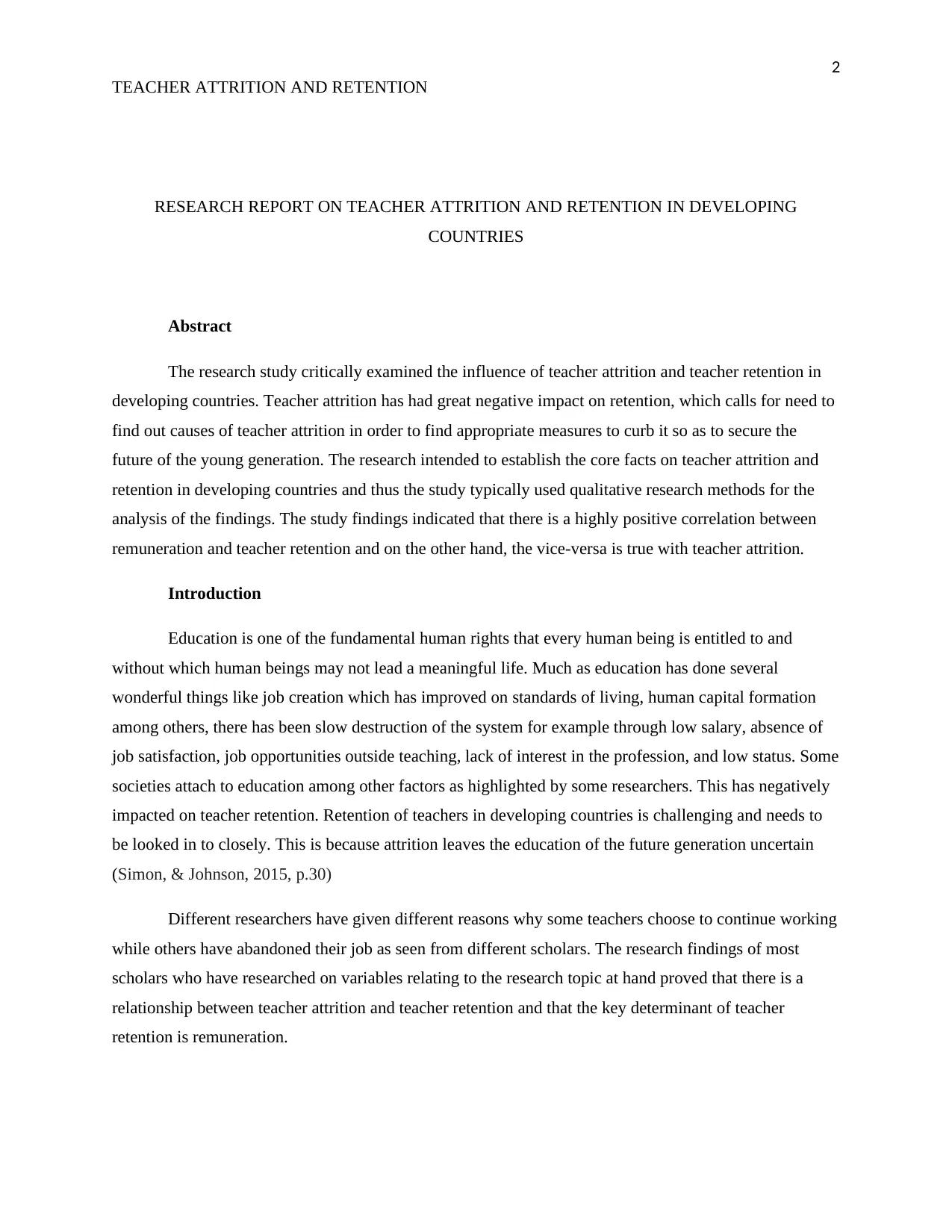
2
TEACHER ATTRITION AND RETENTION
RESEARCH REPORT ON TEACHER ATTRITION AND RETENTION IN DEVELOPING
COUNTRIES
Abstract
The research study critically examined the influence of teacher attrition and teacher retention in
developing countries. Teacher attrition has had great negative impact on retention, which calls for need to
find out causes of teacher attrition in order to find appropriate measures to curb it so as to secure the
future of the young generation. The research intended to establish the core facts on teacher attrition and
retention in developing countries and thus the study typically used qualitative research methods for the
analysis of the findings. The study findings indicated that there is a highly positive correlation between
remuneration and teacher retention and on the other hand, the vice-versa is true with teacher attrition.
Introduction
Education is one of the fundamental human rights that every human being is entitled to and
without which human beings may not lead a meaningful life. Much as education has done several
wonderful things like job creation which has improved on standards of living, human capital formation
among others, there has been slow destruction of the system for example through low salary, absence of
job satisfaction, job opportunities outside teaching, lack of interest in the profession, and low status. Some
societies attach to education among other factors as highlighted by some researchers. This has negatively
impacted on teacher retention. Retention of teachers in developing countries is challenging and needs to
be looked in to closely. This is because attrition leaves the education of the future generation uncertain
(Simon, & Johnson, 2015, p.30)
Different researchers have given different reasons why some teachers choose to continue working
while others have abandoned their job as seen from different scholars. The research findings of most
scholars who have researched on variables relating to the research topic at hand proved that there is a
relationship between teacher attrition and teacher retention and that the key determinant of teacher
retention is remuneration.
TEACHER ATTRITION AND RETENTION
RESEARCH REPORT ON TEACHER ATTRITION AND RETENTION IN DEVELOPING
COUNTRIES
Abstract
The research study critically examined the influence of teacher attrition and teacher retention in
developing countries. Teacher attrition has had great negative impact on retention, which calls for need to
find out causes of teacher attrition in order to find appropriate measures to curb it so as to secure the
future of the young generation. The research intended to establish the core facts on teacher attrition and
retention in developing countries and thus the study typically used qualitative research methods for the
analysis of the findings. The study findings indicated that there is a highly positive correlation between
remuneration and teacher retention and on the other hand, the vice-versa is true with teacher attrition.
Introduction
Education is one of the fundamental human rights that every human being is entitled to and
without which human beings may not lead a meaningful life. Much as education has done several
wonderful things like job creation which has improved on standards of living, human capital formation
among others, there has been slow destruction of the system for example through low salary, absence of
job satisfaction, job opportunities outside teaching, lack of interest in the profession, and low status. Some
societies attach to education among other factors as highlighted by some researchers. This has negatively
impacted on teacher retention. Retention of teachers in developing countries is challenging and needs to
be looked in to closely. This is because attrition leaves the education of the future generation uncertain
(Simon, & Johnson, 2015, p.30)
Different researchers have given different reasons why some teachers choose to continue working
while others have abandoned their job as seen from different scholars. The research findings of most
scholars who have researched on variables relating to the research topic at hand proved that there is a
relationship between teacher attrition and teacher retention and that the key determinant of teacher
retention is remuneration.
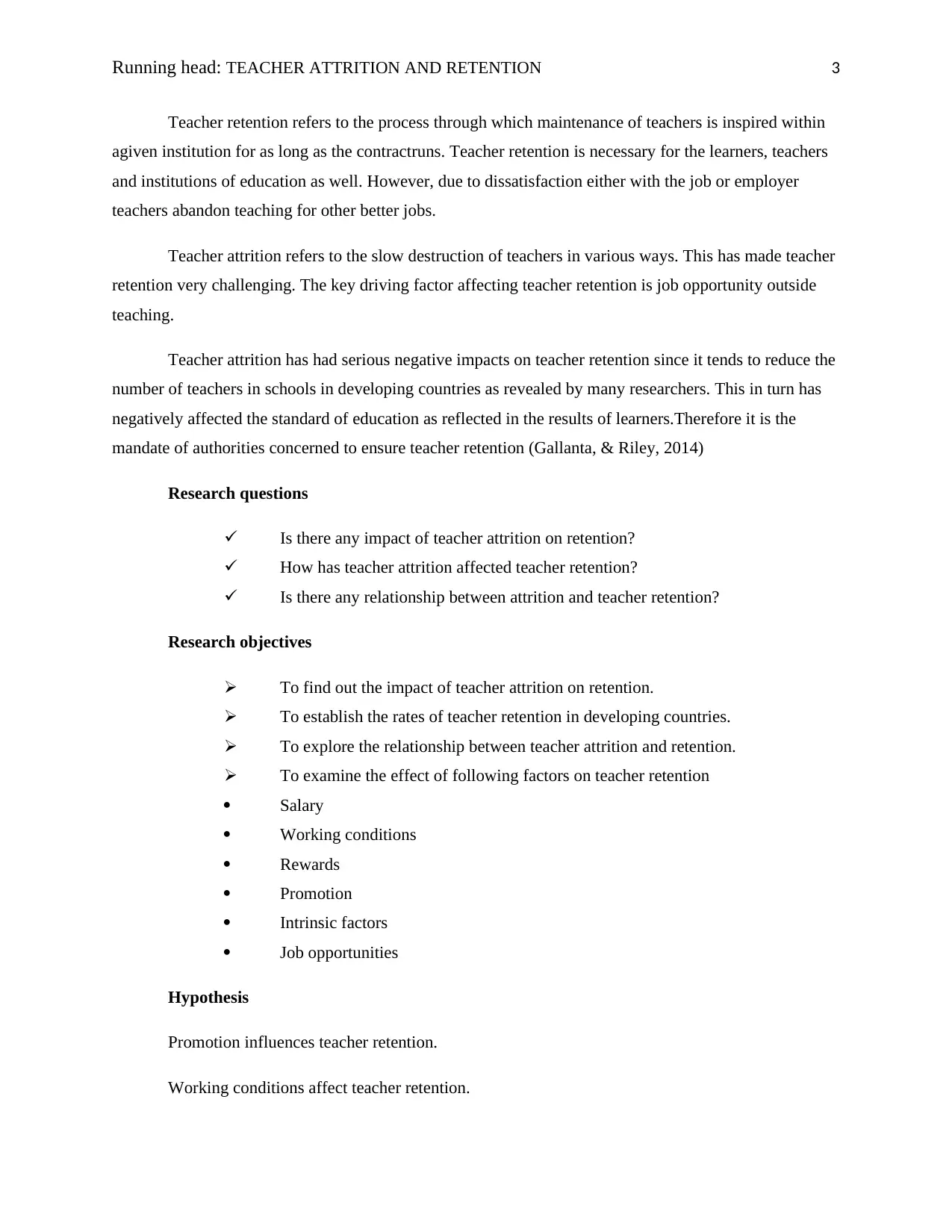
Running head: TEACHER ATTRITION AND RETENTION 3
Teacher retention refers to the process through which maintenance of teachers is inspired within
agiven institution for as long as the contractruns. Teacher retention is necessary for the learners, teachers
and institutions of education as well. However, due to dissatisfaction either with the job or employer
teachers abandon teaching for other better jobs.
Teacher attrition refers to the slow destruction of teachers in various ways. This has made teacher
retention very challenging. The key driving factor affecting teacher retention is job opportunity outside
teaching.
Teacher attrition has had serious negative impacts on teacher retention since it tends to reduce the
number of teachers in schools in developing countries as revealed by many researchers. This in turn has
negatively affected the standard of education as reflected in the results of learners.Therefore it is the
mandate of authorities concerned to ensure teacher retention (Gallanta, & Riley, 2014)
Research questions
Is there any impact of teacher attrition on retention?
How has teacher attrition affected teacher retention?
Is there any relationship between attrition and teacher retention?
Research objectives
To find out the impact of teacher attrition on retention.
To establish the rates of teacher retention in developing countries.
To explore the relationship between teacher attrition and retention.
To examine the effect of following factors on teacher retention
Salary
Working conditions
Rewards
Promotion
Intrinsic factors
Job opportunities
Hypothesis
Promotion influences teacher retention.
Working conditions affect teacher retention.
Teacher retention refers to the process through which maintenance of teachers is inspired within
agiven institution for as long as the contractruns. Teacher retention is necessary for the learners, teachers
and institutions of education as well. However, due to dissatisfaction either with the job or employer
teachers abandon teaching for other better jobs.
Teacher attrition refers to the slow destruction of teachers in various ways. This has made teacher
retention very challenging. The key driving factor affecting teacher retention is job opportunity outside
teaching.
Teacher attrition has had serious negative impacts on teacher retention since it tends to reduce the
number of teachers in schools in developing countries as revealed by many researchers. This in turn has
negatively affected the standard of education as reflected in the results of learners.Therefore it is the
mandate of authorities concerned to ensure teacher retention (Gallanta, & Riley, 2014)
Research questions
Is there any impact of teacher attrition on retention?
How has teacher attrition affected teacher retention?
Is there any relationship between attrition and teacher retention?
Research objectives
To find out the impact of teacher attrition on retention.
To establish the rates of teacher retention in developing countries.
To explore the relationship between teacher attrition and retention.
To examine the effect of following factors on teacher retention
Salary
Working conditions
Rewards
Promotion
Intrinsic factors
Job opportunities
Hypothesis
Promotion influences teacher retention.
Working conditions affect teacher retention.
⊘ This is a preview!⊘
Do you want full access?
Subscribe today to unlock all pages.

Trusted by 1+ million students worldwide
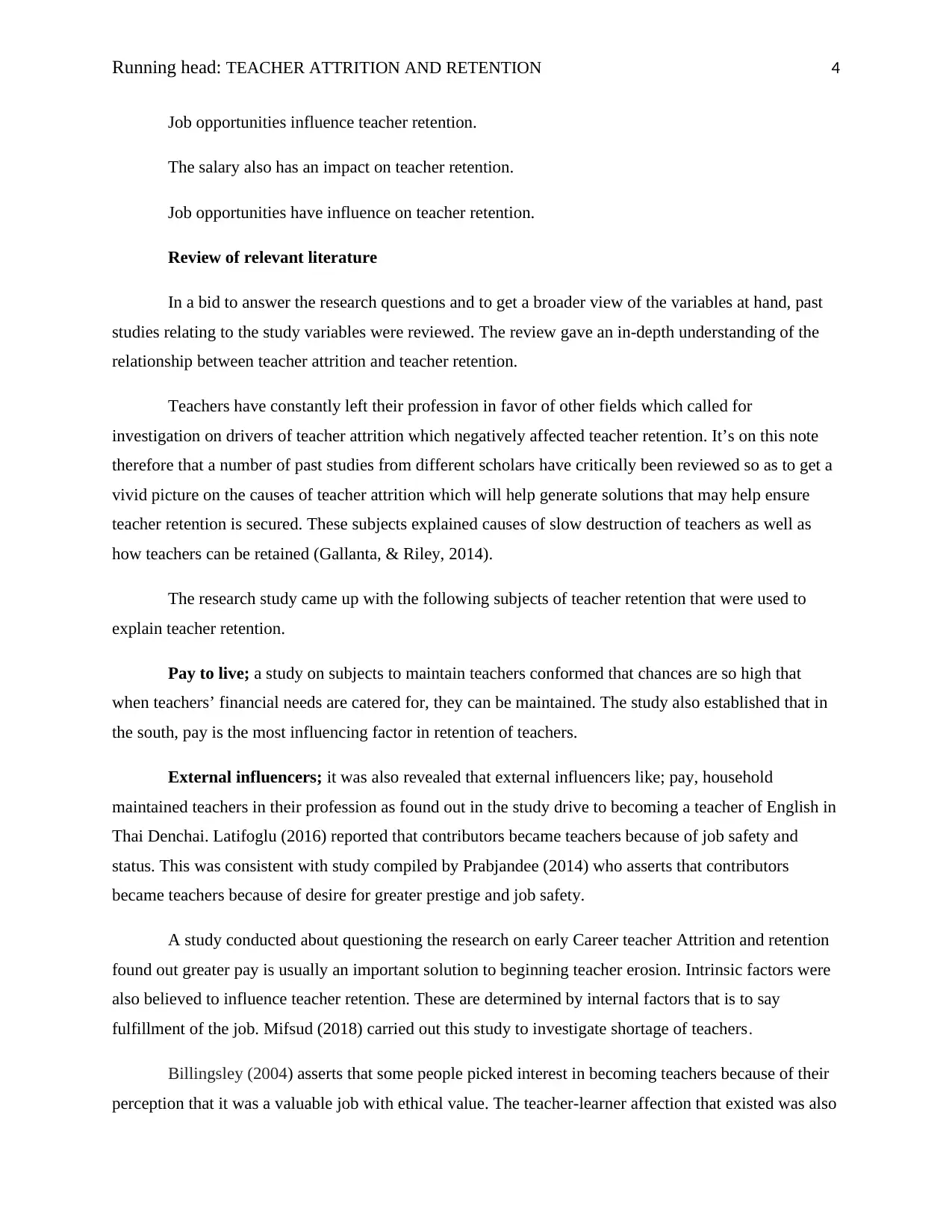
Running head: TEACHER ATTRITION AND RETENTION 4
Job opportunities influence teacher retention.
The salary also has an impact on teacher retention.
Job opportunities have influence on teacher retention.
Review of relevant literature
In a bid to answer the research questions and to get a broader view of the variables at hand, past
studies relating to the study variables were reviewed. The review gave an in-depth understanding of the
relationship between teacher attrition and teacher retention.
Teachers have constantly left their profession in favor of other fields which called for
investigation on drivers of teacher attrition which negatively affected teacher retention. It’s on this note
therefore that a number of past studies from different scholars have critically been reviewed so as to get a
vivid picture on the causes of teacher attrition which will help generate solutions that may help ensure
teacher retention is secured. These subjects explained causes of slow destruction of teachers as well as
how teachers can be retained (Gallanta, & Riley, 2014).
The research study came up with the following subjects of teacher retention that were used to
explain teacher retention.
Pay to live; a study on subjects to maintain teachers conformed that chances are so high that
when teachers’ financial needs are catered for, they can be maintained. The study also established that in
the south, pay is the most influencing factor in retention of teachers.
External influencers; it was also revealed that external influencers like; pay, household
maintained teachers in their profession as found out in the study drive to becoming a teacher of English in
Thai Denchai. Latifoglu (2016) reported that contributors became teachers because of job safety and
status. This was consistent with study compiled by Prabjandee (2014) who asserts that contributors
became teachers because of desire for greater prestige and job safety.
A study conducted about questioning the research on early Career teacher Attrition and retention
found out greater pay is usually an important solution to beginning teacher erosion. Intrinsic factors were
also believed to influence teacher retention. These are determined by internal factors that is to say
fulfillment of the job. Mifsud (2018) carried out this study to investigate shortage of teachers.
Billingsley (2004) asserts that some people picked interest in becoming teachers because of their
perception that it was a valuable job with ethical value. The teacher-learner affection that existed was also
Job opportunities influence teacher retention.
The salary also has an impact on teacher retention.
Job opportunities have influence on teacher retention.
Review of relevant literature
In a bid to answer the research questions and to get a broader view of the variables at hand, past
studies relating to the study variables were reviewed. The review gave an in-depth understanding of the
relationship between teacher attrition and teacher retention.
Teachers have constantly left their profession in favor of other fields which called for
investigation on drivers of teacher attrition which negatively affected teacher retention. It’s on this note
therefore that a number of past studies from different scholars have critically been reviewed so as to get a
vivid picture on the causes of teacher attrition which will help generate solutions that may help ensure
teacher retention is secured. These subjects explained causes of slow destruction of teachers as well as
how teachers can be retained (Gallanta, & Riley, 2014).
The research study came up with the following subjects of teacher retention that were used to
explain teacher retention.
Pay to live; a study on subjects to maintain teachers conformed that chances are so high that
when teachers’ financial needs are catered for, they can be maintained. The study also established that in
the south, pay is the most influencing factor in retention of teachers.
External influencers; it was also revealed that external influencers like; pay, household
maintained teachers in their profession as found out in the study drive to becoming a teacher of English in
Thai Denchai. Latifoglu (2016) reported that contributors became teachers because of job safety and
status. This was consistent with study compiled by Prabjandee (2014) who asserts that contributors
became teachers because of desire for greater prestige and job safety.
A study conducted about questioning the research on early Career teacher Attrition and retention
found out greater pay is usually an important solution to beginning teacher erosion. Intrinsic factors were
also believed to influence teacher retention. These are determined by internal factors that is to say
fulfillment of the job. Mifsud (2018) carried out this study to investigate shortage of teachers.
Billingsley (2004) asserts that some people picked interest in becoming teachers because of their
perception that it was a valuable job with ethical value. The teacher-learner affection that existed was also
Paraphrase This Document
Need a fresh take? Get an instant paraphrase of this document with our AI Paraphraser

Running head: TEACHER ATTRITION AND RETENTION 5
found to have influence on teacher retention. Teachers who had strong affection or love for their learners
found it challenging to leave the job since they had the desire to continue interacting with their learners.
Less intervention from management positively impacted on teacher retention. Study findings proved that
teachers who were not intervened by management or those who were supported by their management
tended to stay teaching. Also hospitality received by teachers from communities or schools granted them
an opportunity to grow professionally and to explore their talents hence benefiting those around them.
Another study on staying or leaving by Latifoglu, (2016) carried out an interview in Victoria
which revealed that quantity of provision to teachers who are new in the field influences how they begin
either with ease or difficulty. This support can be through orientation, mentoring and
meaningfulspecializedexpansion mostly for teachers who are just beginning. They explained that teaching
out of the field was not wanted which leaved teachers traumatized and frustrated and unclear throughout
the service. This posed a challenge on retention of teachers. Another factor as raised by teachers is
absence of teamwork which hindered retention of teachers (Latifoglu, 2016, p.55).
Intrinsic factor which is related to mental affection that teachers attached to their profession was
also said to be determinants of retention of teachers. It was discovered that some teachers joined the
profession due to influence from the experience got at school.
The journey to becoming a Thai English teacher in a resent standpoint on investigating scarcity of
teachers established that some teachers joined the profession because they perceived it to be of high value
and prestige. The study also revealed that three teacher responded that they simply perceived teaching as
equal to superiority which inspired them to join. Still a sense of belonging from societies like; comrades,
learners stewed intellect of belonging for example through the practice of teaching like instruction to
learners. In another study ‘why do they stay ‘proved that safety of jobs and career expansion experiences
influenced teacher retention? Few teachers responded they would continue teaching because of safety of
the jobs in comparison to the private sector (Latifoglu, 2016, p.55).
In the study conducted on questioning of research on early career teacher attrition and retention
found out that use of resources for example money and provision of motivation was very fundamental
especially for maintenance of teachers or instructions in schools with massive poverty. Meanwhile a study
on Gallanta & Riley (2014) established that teachers can be retained when they lead a healthy work-life-
balance and meaningful professional learning activities.
A research on pay to keep living carried out in Zimbabwe by Gomba (2015) discovered that
teachers are most likely to keep working if they are rewarded financially. Established that in the south pay
found to have influence on teacher retention. Teachers who had strong affection or love for their learners
found it challenging to leave the job since they had the desire to continue interacting with their learners.
Less intervention from management positively impacted on teacher retention. Study findings proved that
teachers who were not intervened by management or those who were supported by their management
tended to stay teaching. Also hospitality received by teachers from communities or schools granted them
an opportunity to grow professionally and to explore their talents hence benefiting those around them.
Another study on staying or leaving by Latifoglu, (2016) carried out an interview in Victoria
which revealed that quantity of provision to teachers who are new in the field influences how they begin
either with ease or difficulty. This support can be through orientation, mentoring and
meaningfulspecializedexpansion mostly for teachers who are just beginning. They explained that teaching
out of the field was not wanted which leaved teachers traumatized and frustrated and unclear throughout
the service. This posed a challenge on retention of teachers. Another factor as raised by teachers is
absence of teamwork which hindered retention of teachers (Latifoglu, 2016, p.55).
Intrinsic factor which is related to mental affection that teachers attached to their profession was
also said to be determinants of retention of teachers. It was discovered that some teachers joined the
profession due to influence from the experience got at school.
The journey to becoming a Thai English teacher in a resent standpoint on investigating scarcity of
teachers established that some teachers joined the profession because they perceived it to be of high value
and prestige. The study also revealed that three teacher responded that they simply perceived teaching as
equal to superiority which inspired them to join. Still a sense of belonging from societies like; comrades,
learners stewed intellect of belonging for example through the practice of teaching like instruction to
learners. In another study ‘why do they stay ‘proved that safety of jobs and career expansion experiences
influenced teacher retention? Few teachers responded they would continue teaching because of safety of
the jobs in comparison to the private sector (Latifoglu, 2016, p.55).
In the study conducted on questioning of research on early career teacher attrition and retention
found out that use of resources for example money and provision of motivation was very fundamental
especially for maintenance of teachers or instructions in schools with massive poverty. Meanwhile a study
on Gallanta & Riley (2014) established that teachers can be retained when they lead a healthy work-life-
balance and meaningful professional learning activities.
A research on pay to keep living carried out in Zimbabwe by Gomba (2015) discovered that
teachers are most likely to keep working if they are rewarded financially. Established that in the south pay
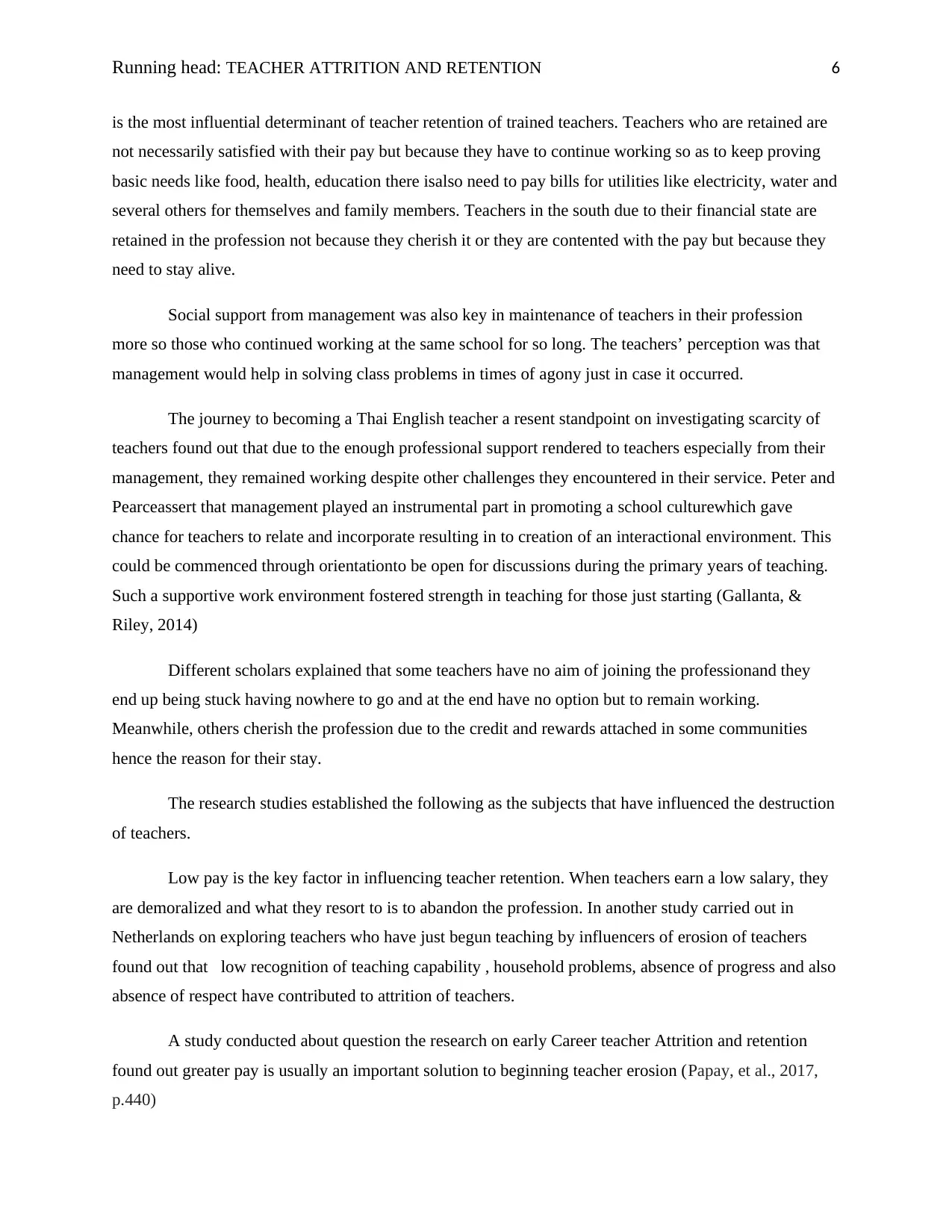
Running head: TEACHER ATTRITION AND RETENTION 6
is the most influential determinant of teacher retention of trained teachers. Teachers who are retained are
not necessarily satisfied with their pay but because they have to continue working so as to keep proving
basic needs like food, health, education there isalso need to pay bills for utilities like electricity, water and
several others for themselves and family members. Teachers in the south due to their financial state are
retained in the profession not because they cherish it or they are contented with the pay but because they
need to stay alive.
Social support from management was also key in maintenance of teachers in their profession
more so those who continued working at the same school for so long. The teachers’ perception was that
management would help in solving class problems in times of agony just in case it occurred.
The journey to becoming a Thai English teacher a resent standpoint on investigating scarcity of
teachers found out that due to the enough professional support rendered to teachers especially from their
management, they remained working despite other challenges they encountered in their service. Peter and
Pearceassert that management played an instrumental part in promoting a school culturewhich gave
chance for teachers to relate and incorporate resulting in to creation of an interactional environment. This
could be commenced through orientationto be open for discussions during the primary years of teaching.
Such a supportive work environment fostered strength in teaching for those just starting (Gallanta, &
Riley, 2014)
Different scholars explained that some teachers have no aim of joining the professionand they
end up being stuck having nowhere to go and at the end have no option but to remain working.
Meanwhile, others cherish the profession due to the credit and rewards attached in some communities
hence the reason for their stay.
The research studies established the following as the subjects that have influenced the destruction
of teachers.
Low pay is the key factor in influencing teacher retention. When teachers earn a low salary, they
are demoralized and what they resort to is to abandon the profession. In another study carried out in
Netherlands on exploring teachers who have just begun teaching by influencers of erosion of teachers
found out that low recognition of teaching capability , household problems, absence of progress and also
absence of respect have contributed to attrition of teachers.
A study conducted about question the research on early Career teacher Attrition and retention
found out greater pay is usually an important solution to beginning teacher erosion (Papay, et al., 2017,
p.440)
is the most influential determinant of teacher retention of trained teachers. Teachers who are retained are
not necessarily satisfied with their pay but because they have to continue working so as to keep proving
basic needs like food, health, education there isalso need to pay bills for utilities like electricity, water and
several others for themselves and family members. Teachers in the south due to their financial state are
retained in the profession not because they cherish it or they are contented with the pay but because they
need to stay alive.
Social support from management was also key in maintenance of teachers in their profession
more so those who continued working at the same school for so long. The teachers’ perception was that
management would help in solving class problems in times of agony just in case it occurred.
The journey to becoming a Thai English teacher a resent standpoint on investigating scarcity of
teachers found out that due to the enough professional support rendered to teachers especially from their
management, they remained working despite other challenges they encountered in their service. Peter and
Pearceassert that management played an instrumental part in promoting a school culturewhich gave
chance for teachers to relate and incorporate resulting in to creation of an interactional environment. This
could be commenced through orientationto be open for discussions during the primary years of teaching.
Such a supportive work environment fostered strength in teaching for those just starting (Gallanta, &
Riley, 2014)
Different scholars explained that some teachers have no aim of joining the professionand they
end up being stuck having nowhere to go and at the end have no option but to remain working.
Meanwhile, others cherish the profession due to the credit and rewards attached in some communities
hence the reason for their stay.
The research studies established the following as the subjects that have influenced the destruction
of teachers.
Low pay is the key factor in influencing teacher retention. When teachers earn a low salary, they
are demoralized and what they resort to is to abandon the profession. In another study carried out in
Netherlands on exploring teachers who have just begun teaching by influencers of erosion of teachers
found out that low recognition of teaching capability , household problems, absence of progress and also
absence of respect have contributed to attrition of teachers.
A study conducted about question the research on early Career teacher Attrition and retention
found out greater pay is usually an important solution to beginning teacher erosion (Papay, et al., 2017,
p.440)
⊘ This is a preview!⊘
Do you want full access?
Subscribe today to unlock all pages.

Trusted by 1+ million students worldwide
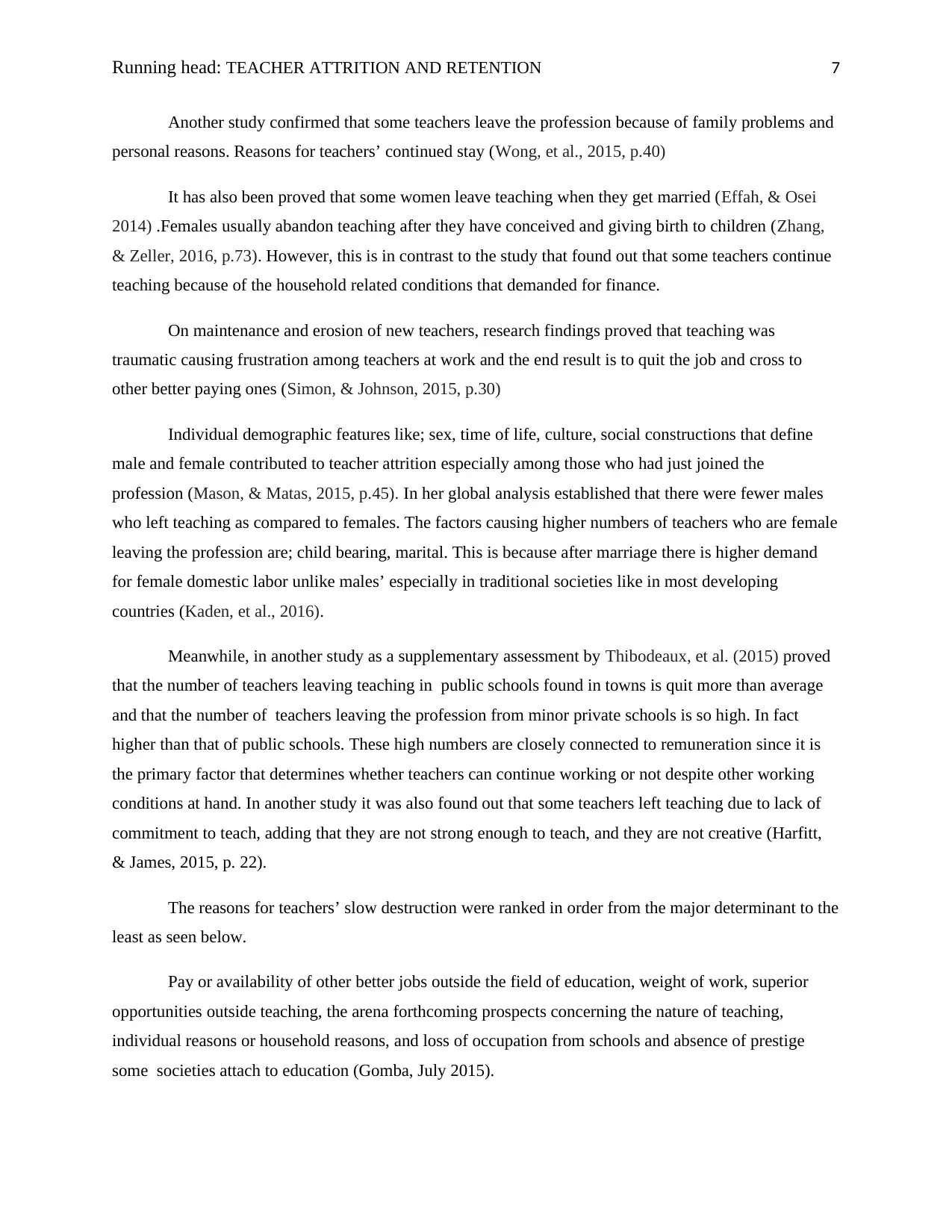
Running head: TEACHER ATTRITION AND RETENTION 7
Another study confirmed that some teachers leave the profession because of family problems and
personal reasons. Reasons for teachers’ continued stay (Wong, et al., 2015, p.40)
It has also been proved that some women leave teaching when they get married (Effah, & Osei
2014) .Females usually abandon teaching after they have conceived and giving birth to children (Zhang,
& Zeller, 2016, p.73). However, this is in contrast to the study that found out that some teachers continue
teaching because of the household related conditions that demanded for finance.
On maintenance and erosion of new teachers, research findings proved that teaching was
traumatic causing frustration among teachers at work and the end result is to quit the job and cross to
other better paying ones (Simon, & Johnson, 2015, p.30)
Individual demographic features like; sex, time of life, culture, social constructions that define
male and female contributed to teacher attrition especially among those who had just joined the
profession (Mason, & Matas, 2015, p.45). In her global analysis established that there were fewer males
who left teaching as compared to females. The factors causing higher numbers of teachers who are female
leaving the profession are; child bearing, marital. This is because after marriage there is higher demand
for female domestic labor unlike males’ especially in traditional societies like in most developing
countries (Kaden, et al., 2016).
Meanwhile, in another study as a supplementary assessment by Thibodeaux, et al. (2015) proved
that the number of teachers leaving teaching in public schools found in towns is quit more than average
and that the number of teachers leaving the profession from minor private schools is so high. In fact
higher than that of public schools. These high numbers are closely connected to remuneration since it is
the primary factor that determines whether teachers can continue working or not despite other working
conditions at hand. In another study it was also found out that some teachers left teaching due to lack of
commitment to teach, adding that they are not strong enough to teach, and they are not creative (Harfitt,
& James, 2015, p. 22).
The reasons for teachers’ slow destruction were ranked in order from the major determinant to the
least as seen below.
Pay or availability of other better jobs outside the field of education, weight of work, superior
opportunities outside teaching, the arena forthcoming prospects concerning the nature of teaching,
individual reasons or household reasons, and loss of occupation from schools and absence of prestige
some societies attach to education (Gomba, July 2015).
Another study confirmed that some teachers leave the profession because of family problems and
personal reasons. Reasons for teachers’ continued stay (Wong, et al., 2015, p.40)
It has also been proved that some women leave teaching when they get married (Effah, & Osei
2014) .Females usually abandon teaching after they have conceived and giving birth to children (Zhang,
& Zeller, 2016, p.73). However, this is in contrast to the study that found out that some teachers continue
teaching because of the household related conditions that demanded for finance.
On maintenance and erosion of new teachers, research findings proved that teaching was
traumatic causing frustration among teachers at work and the end result is to quit the job and cross to
other better paying ones (Simon, & Johnson, 2015, p.30)
Individual demographic features like; sex, time of life, culture, social constructions that define
male and female contributed to teacher attrition especially among those who had just joined the
profession (Mason, & Matas, 2015, p.45). In her global analysis established that there were fewer males
who left teaching as compared to females. The factors causing higher numbers of teachers who are female
leaving the profession are; child bearing, marital. This is because after marriage there is higher demand
for female domestic labor unlike males’ especially in traditional societies like in most developing
countries (Kaden, et al., 2016).
Meanwhile, in another study as a supplementary assessment by Thibodeaux, et al. (2015) proved
that the number of teachers leaving teaching in public schools found in towns is quit more than average
and that the number of teachers leaving the profession from minor private schools is so high. In fact
higher than that of public schools. These high numbers are closely connected to remuneration since it is
the primary factor that determines whether teachers can continue working or not despite other working
conditions at hand. In another study it was also found out that some teachers left teaching due to lack of
commitment to teach, adding that they are not strong enough to teach, and they are not creative (Harfitt,
& James, 2015, p. 22).
The reasons for teachers’ slow destruction were ranked in order from the major determinant to the
least as seen below.
Pay or availability of other better jobs outside the field of education, weight of work, superior
opportunities outside teaching, the arena forthcoming prospects concerning the nature of teaching,
individual reasons or household reasons, and loss of occupation from schools and absence of prestige
some societies attach to education (Gomba, July 2015).
Paraphrase This Document
Need a fresh take? Get an instant paraphrase of this document with our AI Paraphraser
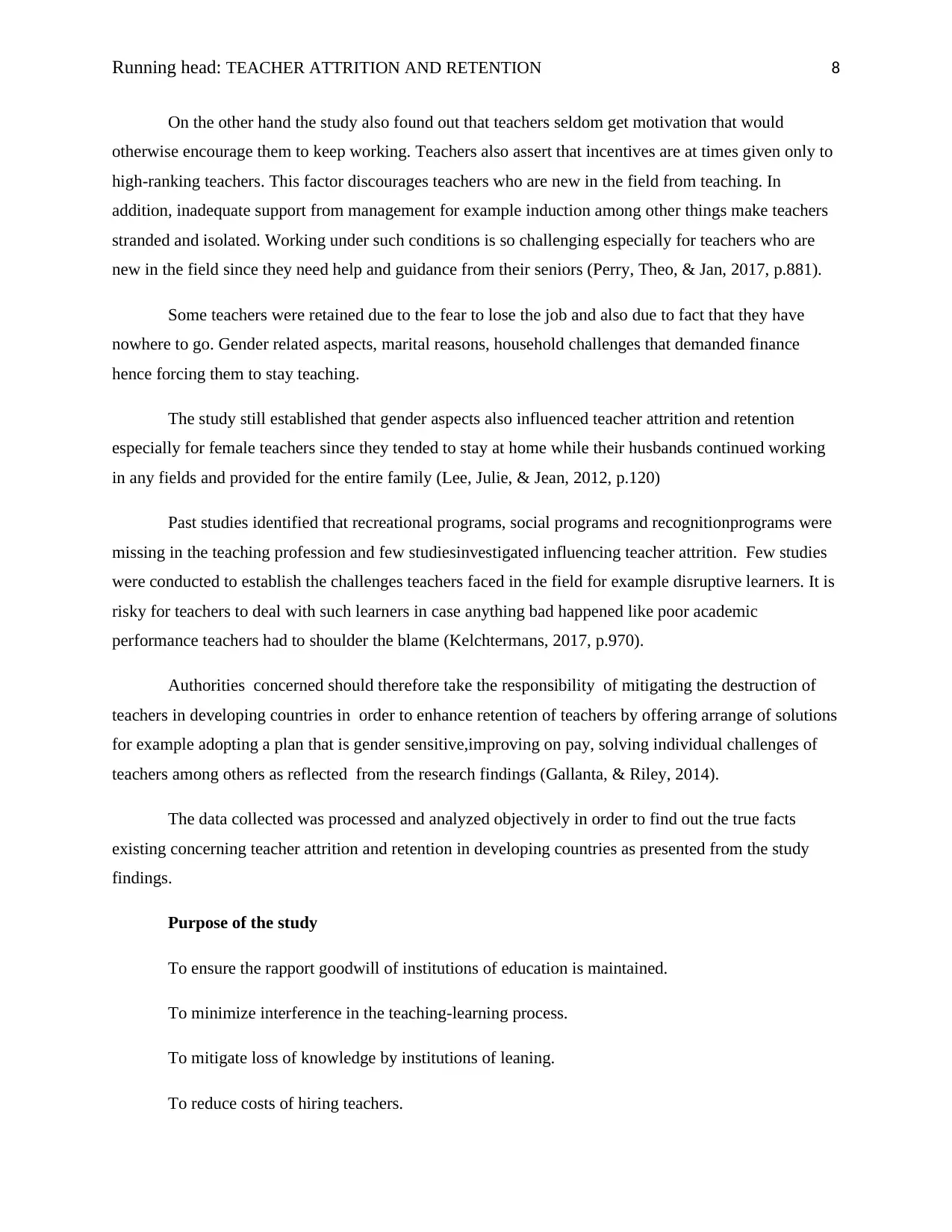
Running head: TEACHER ATTRITION AND RETENTION 8
On the other hand the study also found out that teachers seldom get motivation that would
otherwise encourage them to keep working. Teachers also assert that incentives are at times given only to
high-ranking teachers. This factor discourages teachers who are new in the field from teaching. In
addition, inadequate support from management for example induction among other things make teachers
stranded and isolated. Working under such conditions is so challenging especially for teachers who are
new in the field since they need help and guidance from their seniors (Perry, Theo, & Jan, 2017, p.881).
Some teachers were retained due to the fear to lose the job and also due to fact that they have
nowhere to go. Gender related aspects, marital reasons, household challenges that demanded finance
hence forcing them to stay teaching.
The study still established that gender aspects also influenced teacher attrition and retention
especially for female teachers since they tended to stay at home while their husbands continued working
in any fields and provided for the entire family (Lee, Julie, & Jean, 2012, p.120)
Past studies identified that recreational programs, social programs and recognitionprograms were
missing in the teaching profession and few studiesinvestigated influencing teacher attrition. Few studies
were conducted to establish the challenges teachers faced in the field for example disruptive learners. It is
risky for teachers to deal with such learners in case anything bad happened like poor academic
performance teachers had to shoulder the blame (Kelchtermans, 2017, p.970).
Authorities concerned should therefore take the responsibility of mitigating the destruction of
teachers in developing countries in order to enhance retention of teachers by offering arrange of solutions
for example adopting a plan that is gender sensitive,improving on pay, solving individual challenges of
teachers among others as reflected from the research findings (Gallanta, & Riley, 2014).
The data collected was processed and analyzed objectively in order to find out the true facts
existing concerning teacher attrition and retention in developing countries as presented from the study
findings.
Purpose of the study
To ensure the rapport goodwill of institutions of education is maintained.
To minimize interference in the teaching-learning process.
To mitigate loss of knowledge by institutions of leaning.
To reduce costs of hiring teachers.
On the other hand the study also found out that teachers seldom get motivation that would
otherwise encourage them to keep working. Teachers also assert that incentives are at times given only to
high-ranking teachers. This factor discourages teachers who are new in the field from teaching. In
addition, inadequate support from management for example induction among other things make teachers
stranded and isolated. Working under such conditions is so challenging especially for teachers who are
new in the field since they need help and guidance from their seniors (Perry, Theo, & Jan, 2017, p.881).
Some teachers were retained due to the fear to lose the job and also due to fact that they have
nowhere to go. Gender related aspects, marital reasons, household challenges that demanded finance
hence forcing them to stay teaching.
The study still established that gender aspects also influenced teacher attrition and retention
especially for female teachers since they tended to stay at home while their husbands continued working
in any fields and provided for the entire family (Lee, Julie, & Jean, 2012, p.120)
Past studies identified that recreational programs, social programs and recognitionprograms were
missing in the teaching profession and few studiesinvestigated influencing teacher attrition. Few studies
were conducted to establish the challenges teachers faced in the field for example disruptive learners. It is
risky for teachers to deal with such learners in case anything bad happened like poor academic
performance teachers had to shoulder the blame (Kelchtermans, 2017, p.970).
Authorities concerned should therefore take the responsibility of mitigating the destruction of
teachers in developing countries in order to enhance retention of teachers by offering arrange of solutions
for example adopting a plan that is gender sensitive,improving on pay, solving individual challenges of
teachers among others as reflected from the research findings (Gallanta, & Riley, 2014).
The data collected was processed and analyzed objectively in order to find out the true facts
existing concerning teacher attrition and retention in developing countries as presented from the study
findings.
Purpose of the study
To ensure the rapport goodwill of institutions of education is maintained.
To minimize interference in the teaching-learning process.
To mitigate loss of knowledge by institutions of leaning.
To reduce costs of hiring teachers.
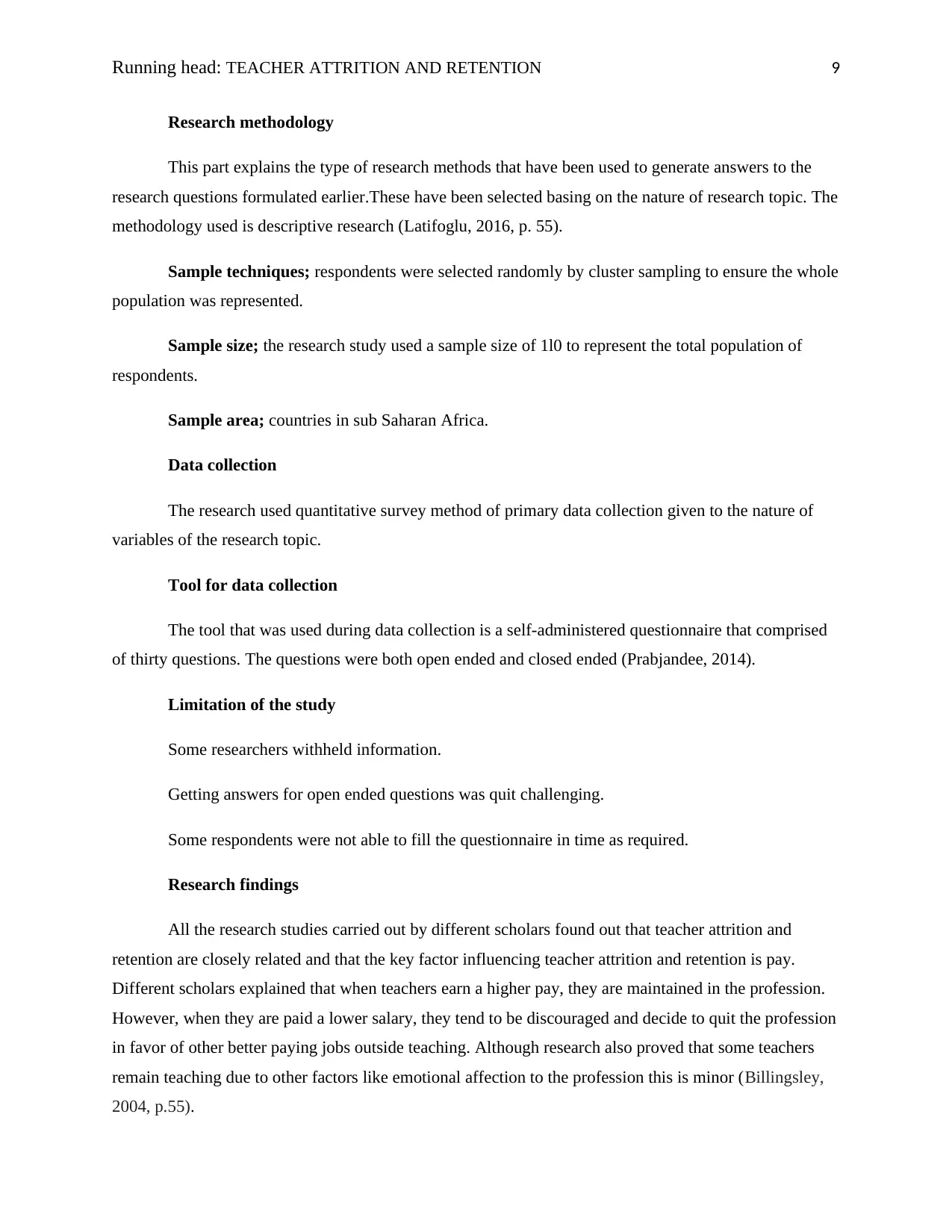
Running head: TEACHER ATTRITION AND RETENTION 9
Research methodology
This part explains the type of research methods that have been used to generate answers to the
research questions formulated earlier.These have been selected basing on the nature of research topic. The
methodology used is descriptive research (Latifoglu, 2016, p. 55).
Sample techniques; respondents were selected randomly by cluster sampling to ensure the whole
population was represented.
Sample size; the research study used a sample size of 1l0 to represent the total population of
respondents.
Sample area; countries in sub Saharan Africa.
Data collection
The research used quantitative survey method of primary data collection given to the nature of
variables of the research topic.
Tool for data collection
The tool that was used during data collection is a self-administered questionnaire that comprised
of thirty questions. The questions were both open ended and closed ended (Prabjandee, 2014).
Limitation of the study
Some researchers withheld information.
Getting answers for open ended questions was quit challenging.
Some respondents were not able to fill the questionnaire in time as required.
Research findings
All the research studies carried out by different scholars found out that teacher attrition and
retention are closely related and that the key factor influencing teacher attrition and retention is pay.
Different scholars explained that when teachers earn a higher pay, they are maintained in the profession.
However, when they are paid a lower salary, they tend to be discouraged and decide to quit the profession
in favor of other better paying jobs outside teaching. Although research also proved that some teachers
remain teaching due to other factors like emotional affection to the profession this is minor (Billingsley,
2004, p.55).
Research methodology
This part explains the type of research methods that have been used to generate answers to the
research questions formulated earlier.These have been selected basing on the nature of research topic. The
methodology used is descriptive research (Latifoglu, 2016, p. 55).
Sample techniques; respondents were selected randomly by cluster sampling to ensure the whole
population was represented.
Sample size; the research study used a sample size of 1l0 to represent the total population of
respondents.
Sample area; countries in sub Saharan Africa.
Data collection
The research used quantitative survey method of primary data collection given to the nature of
variables of the research topic.
Tool for data collection
The tool that was used during data collection is a self-administered questionnaire that comprised
of thirty questions. The questions were both open ended and closed ended (Prabjandee, 2014).
Limitation of the study
Some researchers withheld information.
Getting answers for open ended questions was quit challenging.
Some respondents were not able to fill the questionnaire in time as required.
Research findings
All the research studies carried out by different scholars found out that teacher attrition and
retention are closely related and that the key factor influencing teacher attrition and retention is pay.
Different scholars explained that when teachers earn a higher pay, they are maintained in the profession.
However, when they are paid a lower salary, they tend to be discouraged and decide to quit the profession
in favor of other better paying jobs outside teaching. Although research also proved that some teachers
remain teaching due to other factors like emotional affection to the profession this is minor (Billingsley,
2004, p.55).
⊘ This is a preview!⊘
Do you want full access?
Subscribe today to unlock all pages.

Trusted by 1+ million students worldwide
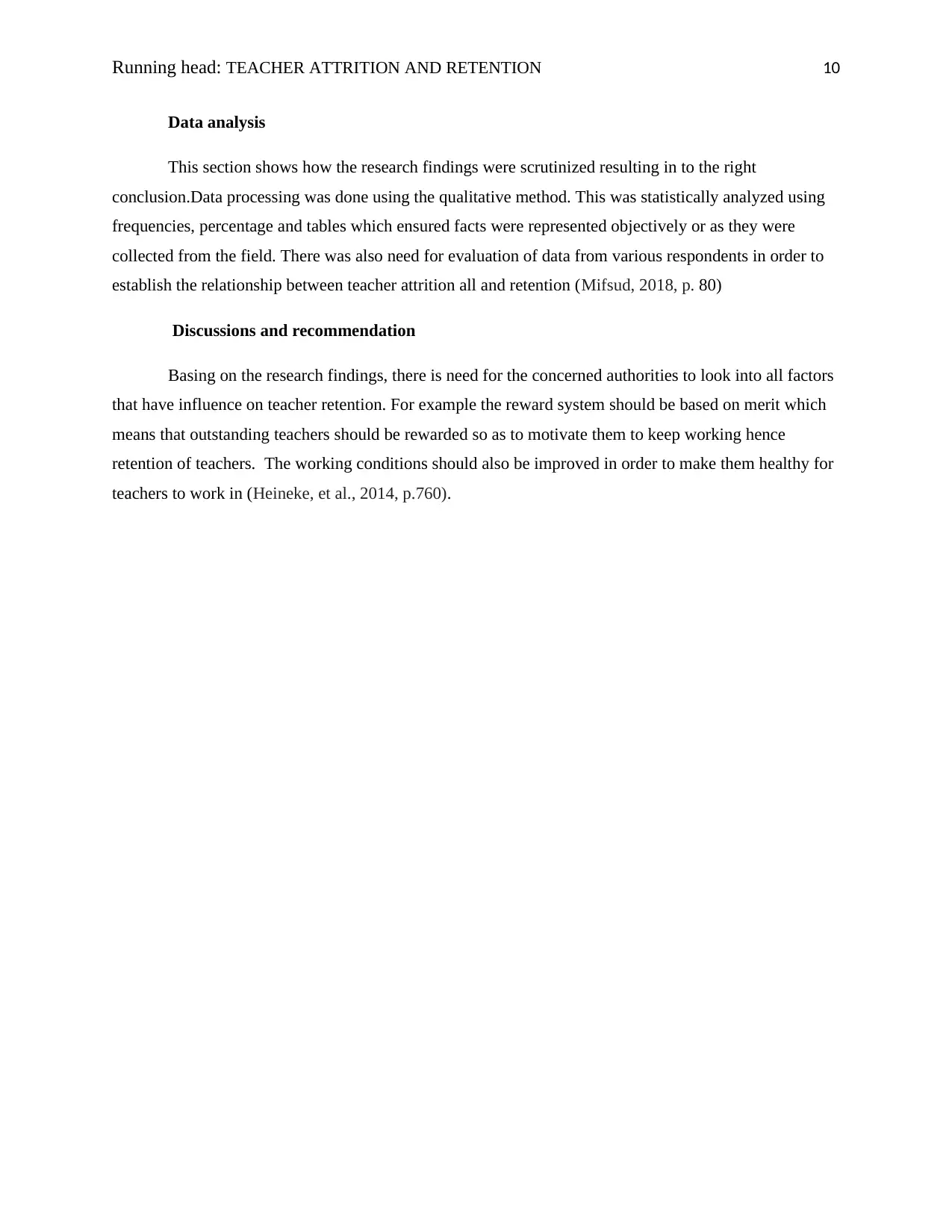
Running head: TEACHER ATTRITION AND RETENTION 10
Data analysis
This section shows how the research findings were scrutinized resulting in to the right
conclusion.Data processing was done using the qualitative method. This was statistically analyzed using
frequencies, percentage and tables which ensured facts were represented objectively or as they were
collected from the field. There was also need for evaluation of data from various respondents in order to
establish the relationship between teacher attrition all and retention (Mifsud, 2018, p. 80)
Discussions and recommendation
Basing on the research findings, there is need for the concerned authorities to look into all factors
that have influence on teacher retention. For example the reward system should be based on merit which
means that outstanding teachers should be rewarded so as to motivate them to keep working hence
retention of teachers. The working conditions should also be improved in order to make them healthy for
teachers to work in (Heineke, et al., 2014, p.760).
Data analysis
This section shows how the research findings were scrutinized resulting in to the right
conclusion.Data processing was done using the qualitative method. This was statistically analyzed using
frequencies, percentage and tables which ensured facts were represented objectively or as they were
collected from the field. There was also need for evaluation of data from various respondents in order to
establish the relationship between teacher attrition all and retention (Mifsud, 2018, p. 80)
Discussions and recommendation
Basing on the research findings, there is need for the concerned authorities to look into all factors
that have influence on teacher retention. For example the reward system should be based on merit which
means that outstanding teachers should be rewarded so as to motivate them to keep working hence
retention of teachers. The working conditions should also be improved in order to make them healthy for
teachers to work in (Heineke, et al., 2014, p.760).
Paraphrase This Document
Need a fresh take? Get an instant paraphrase of this document with our AI Paraphraser
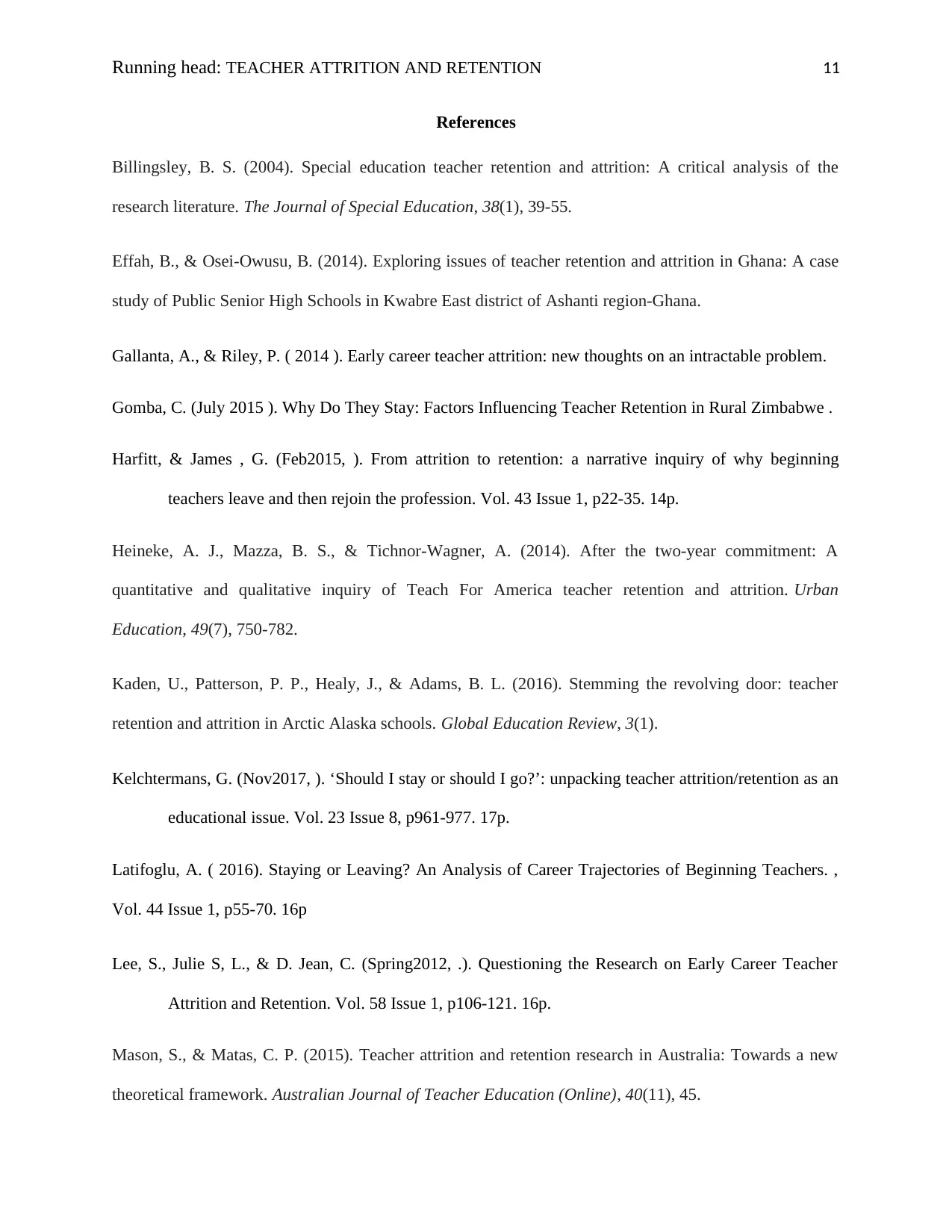
Running head: TEACHER ATTRITION AND RETENTION 11
References
Billingsley, B. S. (2004). Special education teacher retention and attrition: A critical analysis of the
research literature. The Journal of Special Education, 38(1), 39-55.
Effah, B., & Osei-Owusu, B. (2014). Exploring issues of teacher retention and attrition in Ghana: A case
study of Public Senior High Schools in Kwabre East district of Ashanti region-Ghana.
Gallanta, A., & Riley, P. ( 2014 ). Early career teacher attrition: new thoughts on an intractable problem.
Gomba, C. (July 2015 ). Why Do They Stay: Factors Influencing Teacher Retention in Rural Zimbabwe .
Harfitt, & James , G. (Feb2015, ). From attrition to retention: a narrative inquiry of why beginning
teachers leave and then rejoin the profession. Vol. 43 Issue 1, p22-35. 14p.
Heineke, A. J., Mazza, B. S., & Tichnor-Wagner, A. (2014). After the two-year commitment: A
quantitative and qualitative inquiry of Teach For America teacher retention and attrition. Urban
Education, 49(7), 750-782.
Kaden, U., Patterson, P. P., Healy, J., & Adams, B. L. (2016). Stemming the revolving door: teacher
retention and attrition in Arctic Alaska schools. Global Education Review, 3(1).
Kelchtermans, G. (Nov2017, ). ‘Should I stay or should I go?’: unpacking teacher attrition/retention as an
educational issue. Vol. 23 Issue 8, p961-977. 17p.
Latifoglu, A. ( 2016). Staying or Leaving? An Analysis of Career Trajectories of Beginning Teachers. ,
Vol. 44 Issue 1, p55-70. 16p
Lee, S., Julie S, L., & D. Jean, C. (Spring2012, .). Questioning the Research on Early Career Teacher
Attrition and Retention. Vol. 58 Issue 1, p106-121. 16p.
Mason, S., & Matas, C. P. (2015). Teacher attrition and retention research in Australia: Towards a new
theoretical framework. Australian Journal of Teacher Education (Online), 40(11), 45.
References
Billingsley, B. S. (2004). Special education teacher retention and attrition: A critical analysis of the
research literature. The Journal of Special Education, 38(1), 39-55.
Effah, B., & Osei-Owusu, B. (2014). Exploring issues of teacher retention and attrition in Ghana: A case
study of Public Senior High Schools in Kwabre East district of Ashanti region-Ghana.
Gallanta, A., & Riley, P. ( 2014 ). Early career teacher attrition: new thoughts on an intractable problem.
Gomba, C. (July 2015 ). Why Do They Stay: Factors Influencing Teacher Retention in Rural Zimbabwe .
Harfitt, & James , G. (Feb2015, ). From attrition to retention: a narrative inquiry of why beginning
teachers leave and then rejoin the profession. Vol. 43 Issue 1, p22-35. 14p.
Heineke, A. J., Mazza, B. S., & Tichnor-Wagner, A. (2014). After the two-year commitment: A
quantitative and qualitative inquiry of Teach For America teacher retention and attrition. Urban
Education, 49(7), 750-782.
Kaden, U., Patterson, P. P., Healy, J., & Adams, B. L. (2016). Stemming the revolving door: teacher
retention and attrition in Arctic Alaska schools. Global Education Review, 3(1).
Kelchtermans, G. (Nov2017, ). ‘Should I stay or should I go?’: unpacking teacher attrition/retention as an
educational issue. Vol. 23 Issue 8, p961-977. 17p.
Latifoglu, A. ( 2016). Staying or Leaving? An Analysis of Career Trajectories of Beginning Teachers. ,
Vol. 44 Issue 1, p55-70. 16p
Lee, S., Julie S, L., & D. Jean, C. (Spring2012, .). Questioning the Research on Early Career Teacher
Attrition and Retention. Vol. 58 Issue 1, p106-121. 16p.
Mason, S., & Matas, C. P. (2015). Teacher attrition and retention research in Australia: Towards a new
theoretical framework. Australian Journal of Teacher Education (Online), 40(11), 45.
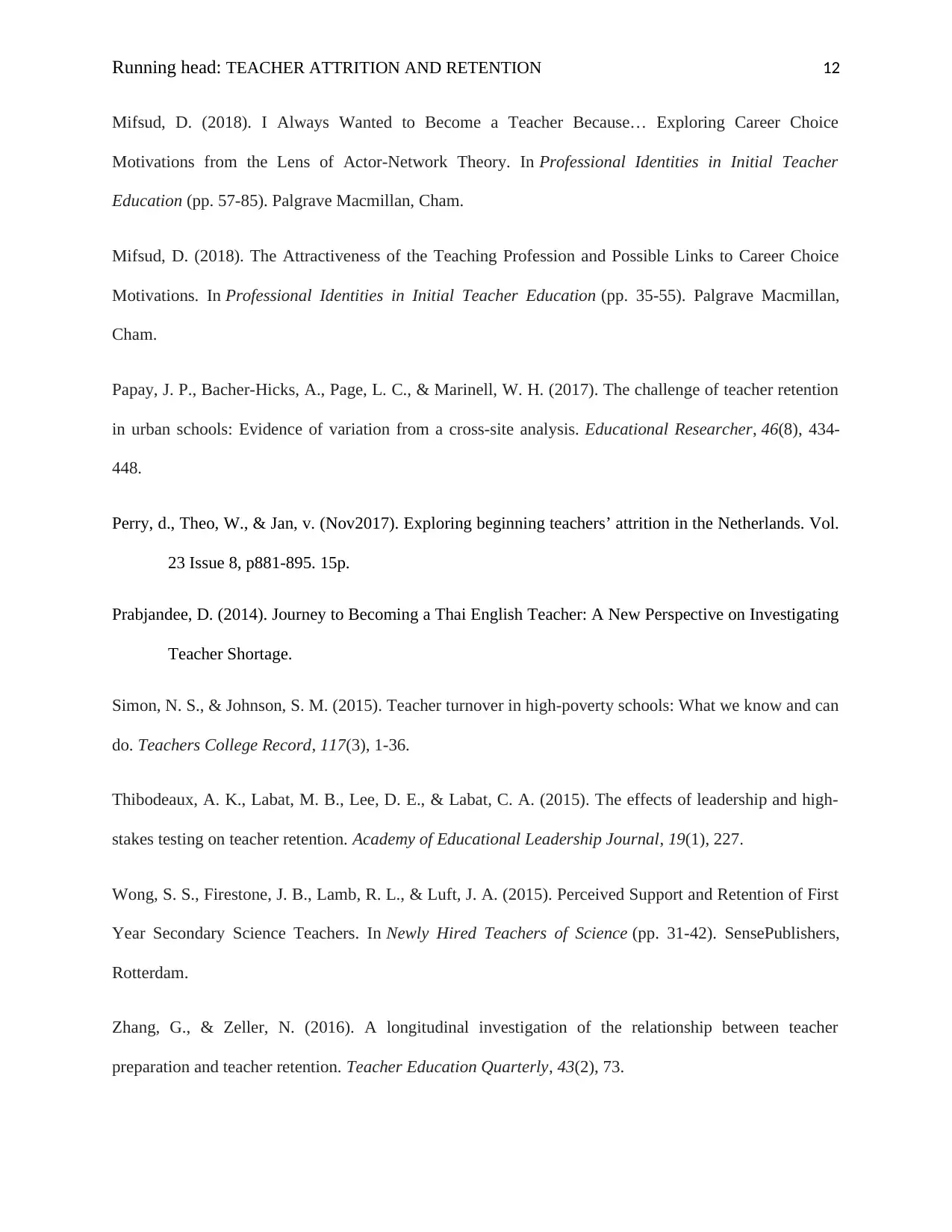
Running head: TEACHER ATTRITION AND RETENTION 12
Mifsud, D. (2018). I Always Wanted to Become a Teacher Because… Exploring Career Choice
Motivations from the Lens of Actor-Network Theory. In Professional Identities in Initial Teacher
Education (pp. 57-85). Palgrave Macmillan, Cham.
Mifsud, D. (2018). The Attractiveness of the Teaching Profession and Possible Links to Career Choice
Motivations. In Professional Identities in Initial Teacher Education (pp. 35-55). Palgrave Macmillan,
Cham.
Papay, J. P., Bacher-Hicks, A., Page, L. C., & Marinell, W. H. (2017). The challenge of teacher retention
in urban schools: Evidence of variation from a cross-site analysis. Educational Researcher, 46(8), 434-
448.
Perry, d., Theo, W., & Jan, v. (Nov2017). Exploring beginning teachers’ attrition in the Netherlands. Vol.
23 Issue 8, p881-895. 15p.
Prabjandee, D. (2014). Journey to Becoming a Thai English Teacher: A New Perspective on Investigating
Teacher Shortage.
Simon, N. S., & Johnson, S. M. (2015). Teacher turnover in high-poverty schools: What we know and can
do. Teachers College Record, 117(3), 1-36.
Thibodeaux, A. K., Labat, M. B., Lee, D. E., & Labat, C. A. (2015). The effects of leadership and high-
stakes testing on teacher retention. Academy of Educational Leadership Journal, 19(1), 227.
Wong, S. S., Firestone, J. B., Lamb, R. L., & Luft, J. A. (2015). Perceived Support and Retention of First
Year Secondary Science Teachers. In Newly Hired Teachers of Science (pp. 31-42). SensePublishers,
Rotterdam.
Zhang, G., & Zeller, N. (2016). A longitudinal investigation of the relationship between teacher
preparation and teacher retention. Teacher Education Quarterly, 43(2), 73.
Mifsud, D. (2018). I Always Wanted to Become a Teacher Because… Exploring Career Choice
Motivations from the Lens of Actor-Network Theory. In Professional Identities in Initial Teacher
Education (pp. 57-85). Palgrave Macmillan, Cham.
Mifsud, D. (2018). The Attractiveness of the Teaching Profession and Possible Links to Career Choice
Motivations. In Professional Identities in Initial Teacher Education (pp. 35-55). Palgrave Macmillan,
Cham.
Papay, J. P., Bacher-Hicks, A., Page, L. C., & Marinell, W. H. (2017). The challenge of teacher retention
in urban schools: Evidence of variation from a cross-site analysis. Educational Researcher, 46(8), 434-
448.
Perry, d., Theo, W., & Jan, v. (Nov2017). Exploring beginning teachers’ attrition in the Netherlands. Vol.
23 Issue 8, p881-895. 15p.
Prabjandee, D. (2014). Journey to Becoming a Thai English Teacher: A New Perspective on Investigating
Teacher Shortage.
Simon, N. S., & Johnson, S. M. (2015). Teacher turnover in high-poverty schools: What we know and can
do. Teachers College Record, 117(3), 1-36.
Thibodeaux, A. K., Labat, M. B., Lee, D. E., & Labat, C. A. (2015). The effects of leadership and high-
stakes testing on teacher retention. Academy of Educational Leadership Journal, 19(1), 227.
Wong, S. S., Firestone, J. B., Lamb, R. L., & Luft, J. A. (2015). Perceived Support and Retention of First
Year Secondary Science Teachers. In Newly Hired Teachers of Science (pp. 31-42). SensePublishers,
Rotterdam.
Zhang, G., & Zeller, N. (2016). A longitudinal investigation of the relationship between teacher
preparation and teacher retention. Teacher Education Quarterly, 43(2), 73.
⊘ This is a preview!⊘
Do you want full access?
Subscribe today to unlock all pages.

Trusted by 1+ million students worldwide
1 out of 13
Related Documents
Your All-in-One AI-Powered Toolkit for Academic Success.
+13062052269
info@desklib.com
Available 24*7 on WhatsApp / Email
![[object Object]](/_next/static/media/star-bottom.7253800d.svg)
Unlock your academic potential
Copyright © 2020–2025 A2Z Services. All Rights Reserved. Developed and managed by ZUCOL.



